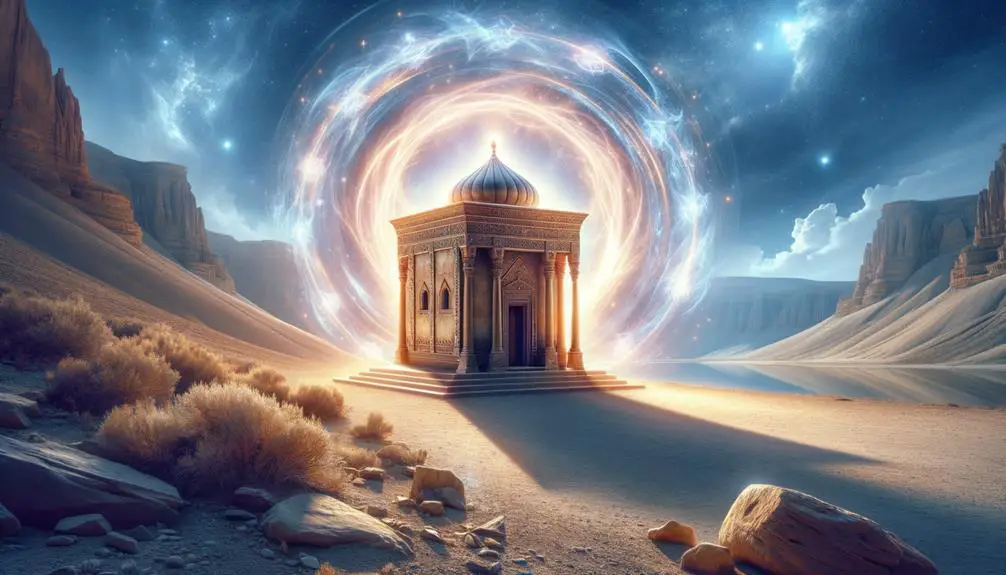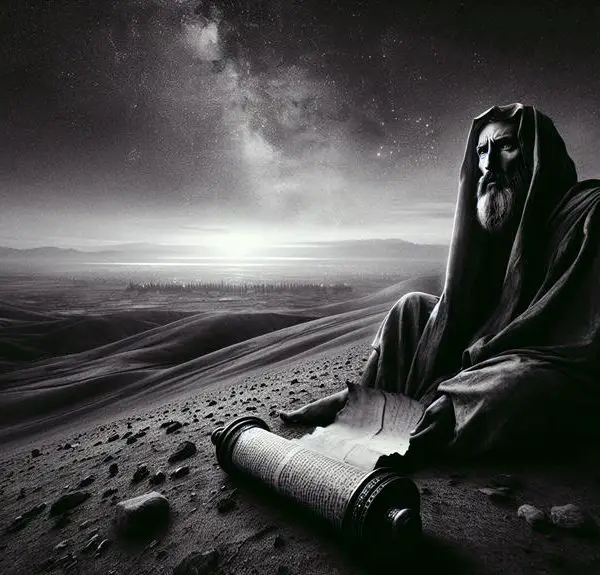Journey through biblical landscapes where heaven meets earth, uncovering divine secrets hidden within ancient, sacred sites.

Where Is Heaven on Earth in the Bible
Isn't it curious how often you've walked past places, unaware of their stories or significance, much like the concept of heaven on earth in the Bible? You've likely heard of the Garden of Eden, Mount Sinai, and Solomon's Temple, but have you considered how these locations serve as intersections between the divine and the mundane?
These aren't just historical sites; they're moments where heaven touches earth, offering glimpses into the divine. As you explore this idea further, you'll uncover layers of meaning and encounter profound insights into how these earthly locations mirror heavenly realities, leaving you to ponder the sacred spaces around and within us.
Key Takeaways
- The Garden of Eden represents the initial and ideal state of Heaven on Earth, showcasing perfect harmony between humanity and the divine.
- The Tabernacle and Solomon's Temple symbolize physical spaces where heaven intersects with earth, embodying God's presence among His people.
- Jesus' earthly ministry, through miracles and parables, demonstrates Heaven on Earth by bridging the divine with human experiences.
- Prophetic visions and encounters, like those at Mount Sinai, offer glimpses of heavenly realities, guiding and shaping human understanding of divine presence.
The Garden of Eden

The Garden of Eden, often depicted as the epitome of paradise in biblical narratives, serves as humanity's original habitat, intricately designed with both aesthetic appeal and profound symbolic significance. This setting isn't just a backdrop for the dawn of human existence but a critical stage for pivotal events that shape theological and moral discussions.
When you delve into the narrative, you'll find that Adam's creation marks not only the inception of humanity but also a divine experiment in free will and obedience. Placed in Eden, Adam is tasked with tending to this divine garden, showcasing the envisioned harmony between humanity and nature. This responsibility underscores a stewardship model, suggesting that humans aren't mere inhabitants of the earth but caretakers of its sanctity and beauty.
However, the Serpent's deception introduces a complex layer of moral and ethical dilemmas. The Serpent, often interpreted as the embodiment of evil or temptation, challenges the trust and obedience Adam and Eve have towards their creator. This act of deception doesn't just lead to the fall of humanity by introducing sin but also sets a precedent for the struggle between good and evil, obedience and rebellion.
In analyzing the Garden of Eden, you're not just exploring a mythical paradise but dissecting a narrative filled with themes of innocence, temptation, free will, and the consequences of actions. The events in this garden lay the foundational ethos for understanding humanity's perpetual quest for redemption and the complex relationship between creator and creation. Here, in Eden, the stage is set for an eternal narrative that resonates through generations, encapsulating the essence of human nature and divine expectation.
Mount Sinai Encounter
In the biblical narrative, Mount Sinai emerges as a pivotal location where divine communication bridges the human and the sacred, fundamentally altering the course of religious history. This desert trek, under Moses' leadership, signifies more than just a physical journey; it represents a transformative passage towards establishing a covenantal relationship between God and the Israelites.
You witness, through the text, how Mount Sinai becomes the backdrop for one of the most significant theophanies in the Bible. Here, Moses ascends the mountain, leaving behind the Israelites, to commune directly with God. This moment underscores the profound shift in how divine interaction is mediated. It's not merely about the physical ascent but symbolizes the spiritual elevation required to receive God's law. Moses' leadership is tested and affirmed, as he acts as the intermediary between the divine and his people.
The encounter at Mount Sinai encapsulates a unique convergence of the divine and the earthly. It's a testament to the belief that heaven can touch earth, transforming ordinary locations into sacred spaces through divine presence. This event marks a departure from the nomadic wanderings in the desert, offering a glimpse of divine order amidst chaos.
Analyzing this episode, you realize the intricate relationship between place, divine encounter, and leadership. Mount Sinai stands as a testament to the possibility of encountering the sacred within the terrestrial realm, shaped by leadership that navigates the complex dynamics of faith, obedience, and divine revelation. Moses' role is crucial, mediating this pivotal moment where heaven and earth collide, setting the stage for the future unfolding of Israel's religious identity.
The Tabernacle Presence

Following the transformative event at Mount Sinai, God's presence finds a new domicile within the Tabernacle, signifying a shift from a singular, monumental encounter to a portable, pervasive divine communion with the Israelites. This transition underscores a profound theological evolution: the divine is no longer confined to a remote, inaccessible location but travels with the people, encapsulated within the Tabernacle's divine architecture. The Tabernacle, with its sacred furnishings, becomes a microcosmic representation of heaven on earth, a tangible manifestation of God's proximity and availability to His chosen people.
This divine architecture is meticulously described in the scriptures, emphasizing not just the physical structure but the symbolic meanings behind each component. The Ark of the Covenant, housed within the Holy of Holies, serves as the most tangible symbol of God's presence. Its location and the stringent regulations surrounding its accessibility underscore the sacredness of God's proximity. Meanwhile, other sacred furnishings within the Tabernacle—the menorah, the table for showbread, and the altar of incense—each play a role in facilitating the Israelites' worship, symbolizing light, sustenance, and prayer, respectively.
The Tabernacle's presence among the Israelites serves as a perpetual reminder of God's covenant, a physical symbol of divine protection and guidance. It's a mobile heaven, a space where heaven and earth converge, allowing the divine and the human to interact in a profoundly intimate manner. This portable dwelling underscores a covenantal relationship that's dynamic and responsive, adapting to the nomadic lifestyle of the Israelites while maintaining a continuous, sacred space for divine-human interaction.
Solomon's Temple
Transitioning from the transient Tabernacle, Solomon's Temple marked a pivotal shift in the locus of divine-human interaction, anchoring God's presence in a permanent, majestic edifice. This transformation wasn't merely architectural but theological, symbolizing a deeper, more enduring covenant between God and His people. You see, Solomon's Temple wasn't just an architectural marvel; it was a theological statement, embodying the unification of heaven and earth.
Constructed under King Solomon's reign, this temple epitomized the zenith of Israelite craftsmanship and religious devotion. Its design and construction, detailed in the Hebrew Bible, showcased an unparalleled commitment to creating a dwelling place for the divine. As an architectural marvel, the temple's grandeur and complexity reflected the importance of the divine-human relationship. Its intricate details, from the cherubim to the gold overlay, weren't just for aesthetic pleasure but served to underscore the sanctity of the space.
Central to the temple's function was the sacrificial system, a core aspect of Israelite worship. This system, intricate and meticulously ordained, facilitated atonement and communion with God. It's here that you'd witness the profound interplay between the tangible and intangible, where offerings of smoke and the scent of incense represented the prayers and repentance of God's people. The temple thus served not only as a physical space for worship but as a focal point for the spiritual life of the nation, a place where heaven touched earth.
In essence, Solomon's Temple encapsulated the hopes, fears, and spiritual aspirations of a people seeking to maintain a tangible connection with the divine. Through its construction and operation, it narrated a story of faith, devotion, and divine presence, setting a precedent for future generations.
The Prophetic Visions

Amid the tangible grandeur of Solomon's Temple, prophetic visions emerged as critical channels through which divine messages and future promises were communicated to the people. These visions, rich with divine metaphors and allusions to celestial realms, served not only as forewarnings but also as beacons of hope, illustrating a heaven on earth that transcended the physical confines of the temple.
Prophets like Isaiah and Ezekiel, through their vivid depictions, played pivotal roles in shaping the Israelites' understanding of their relationship with the divine. Their portrayals of heaven on earth weren't mere fanciful dreams but were deeply embedded in the cultural and religious consciousness of their time. These visions offered a glimpse into a future where divine presence and human existence were in perfect harmony.
To grasp the significance of these prophetic visions, consider the following:
- Divine metaphors: They utilized powerful imagery, such as the heavenly throne or the New Jerusalem, to symbolize an intimate connection between God and His people.
- Celestial realms: Descriptions of otherworldly realms served to remind the faithful of the transcendent nature of their God and the ultimate promise of salvation.
- Symbolic representations: The temple itself became a symbol of the cosmic mountain, bridging heaven and earth, and serving as a constant reminder of God's presence among His people.
These elements collectively underscored the prophetic visions' role in cultivating a spiritual landscape where heaven intersected with the earthly realm, promising a future where divine and human realms would finally converge in perfect unity.
Jesus' Earthly Ministry
As you explore Jesus' earthly ministry, you'll find that his miracles and teaching parables were pivotal in manifesting the concept of Heaven on Earth. His actions and stories not only demonstrated divine power but also conveyed profound moral and spiritual truths.
These elements serve as foundational to understanding how Jesus aimed to bridge the divine with the mundane, inviting a deeper reflection on the nature of Heaven's presence in the earthly realm.
Miracles of Jesus
Throughout His earthly ministry, Jesus performed numerous miracles that not only manifested His divine authority but also profoundly impacted the lives of individuals and communities. These acts of divine intervention served as tangible demonstrations of heaven's power on earth, revealing Jesus' compassion and the kingdom of God's imminent reality.
- Healing lepers: This act not only restored physical health but also social identity and community standing, challenging societal norms and demonstrating the kingdom's inclusivity.
- Walking on water: This miracle underscored Jesus' mastery over the natural world, reinforcing His divine nature and the disciples' faith.
- Feeding thousands: By miraculously multiplying loaves and fishes, Jesus addressed immediate physical needs while illustrating the spiritual abundance found in His teachings.
These miracles, among others, signify key aspects of Jesus' ministry, emphasizing His role as healer, provider, and the Son of God.
Teaching Parables
While miracles showcased Jesus' divine power and compassion, His teaching of parables revealed profound spiritual truths, inviting listeners into deeper reflection on the kingdom of God. Through stories like the lost sheep and the prodigal son, you're prompted to ponder themes of redemption, forgiveness, and the infinite love of the Father.
These narratives aren't just tales but are layered with symbolic meaning, illustrating the nature of divine grace and the joy in reclaiming what was lost. The parable of the lost sheep emphasizes God's persistence in seeking out even one lost soul, while the prodigal son highlights the boundless forgiveness awaiting those who return.
Through this analytical lens, these parables serve as a bridge, connecting earthly experiences with heavenly ideals, urging you to see beyond the surface to the eternal truths they embody.
Frequently Asked Questions
How Do Different Religious Traditions Interpret the Concept of "Heaven on Earth" as Mentioned in the Bible?
Different religious traditions each have their unique take on the Bible's concept of 'heaven on earth.' They often reflect on the Garden of Eden as the original paradise, interpreting it through diverse lenses of divine revelations. These perspectives vary, analyzing it as both a historical place and a metaphor for spiritual fulfillment.
Scholars dig into texts, seeking to understand how these interpretations impact faith and daily living, offering rich, contextual analyses.
Are There Any Archaeological Findings That Support the Biblical Descriptions of Heaven on Earth Locations?
You're delving into whether archaeological findings back the Bible's portrayal of heaven on earth spots like the Garden of Eden or Heavenly Jerusalem. While scholarly efforts have explored these narratives, concrete evidence remains elusive.
Theoretical locations are proposed, yet definitive proof is hard to come by. This lack of tangible findings doesn't diminish the cultural and spiritual significance of these places, but it does challenge historical validation from an archaeological standpoint.
How Do Modern Theologians Reconcile the Idea of Heaven on Earth With the Scientific Understanding of the Universe?
You're exploring how modern theologians navigate the concept of heaven on earth alongside current scientific understandings. They engage in scientific reconciliation, carefully blending scriptural interpretations with empirical evidence.
Through theological adaptation, they're updating traditional views to align with cosmological discoveries. This approach doesn't dilute faith; instead, it enhances comprehension of the divine in a universe that science continues to unravel, allowing for a more nuanced, harmonious belief system.
How Has the Concept of Heaven on Earth Influenced Art, Literature, and Culture Throughout History?
You've seen how the idea of heaven on earth has deeply influenced art, literature, and culture, shaping visions of utopia and inspiring countless works.
This concept, infused with notions of heavenly architecture and divine inspiration, has been a wellspring for creativity. Artists and writers have drawn on this rich tapestry to craft narratives and constructs that reflect both the divine and the human aspiration for a perfected world.
What Are the Ethical and Moral Implications of Striving to Create a Heaven on Earth in the Context of Contemporary Global Issues?
You're diving into the ethical and moral implications of striving for a utopia amidst contemporary global issues.
When considering climate change and economic inequality, it's crucial to analyze how these pursuits impact society.
Striving for a 'heaven on earth' can inspire progressive change, yet it's vital to question who benefits and at what cost.
This analysis requires a balance between idealism and practicality to ensure equitable solutions for all.
Conclusion
In your journey through biblical landscapes, you've traversed from Eden's lush gardens to Sinai's thunderous peaks, witnessed the divine sheen within the Tabernacle, and marveled at Solomon's grand temple. Through prophetic visions, you've glimpsed into realms beyond, while Jesus' earthly sojourn brought heaven's touch to the dust of Galilee.
Each locale, a mosaic piece, illustrates heaven's shadow on earth, inviting contemplation on the divine-human intersection. Here, in these sacred spaces, heaven and earth intertwine, offering glimpses into the transcendent.



Sign up